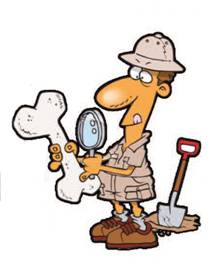
Salty Sam’s Fun Blog for Children
Number 470
Archaeology
Hello Everyone
So what does the word at the top of the blog post this week mean?
lt isn’t easy to spell, is it?
Well, it means the science of discovering things about history by looking at objects.
The whole country is like a trifle!
The more you dig into it, the more you can go back in time and discover layers of the past.
Layers of Roman artefacts will be below Victorian ones for example.
lt is amazing how a trained eye can pick up something that looks like a bit of stone to the rest of us and say with authority that it is a bit of Roman pot – or mediaeval pot – or Victorian pot.
ln fact, there is so much to know about different things that could be found in an archaeological dig, that you will find that archaeologists often have specialist fields that they work in.
One might know a lot about skeletons and one about pottery and another about coins.
Some might know a lot about Roman history and another about the Bronze Age, for example.
Archaeologists often find bits and pieces of objects and buried foundations of buildings by digging into the ground. Sometimes they have to go quite a long way down.
Sometimes they have to go down so far that they have to shore up the sides of the hole they are working in with planks or some kind of walling to make sure the earth doesn’t fall in on them – which would be very dangerous. This is especially true when the soil they are digging in is soft and sandy.
So how do archaeologists know where to start digging?
Well, there are different ways to find a good place to dig for archaeological finds.
Sometimes houses are built in a place where one has been knocked down and sometimes they are built on land that has been unoccupied for a long time.
lf builders are digging into the earth and find things that look ancient, they have to inform the local authority and work must stop for archaeologists to come and investigate the hole.
lf the builders find a human skeleton they will call the police.
lf the skeleton is found to be over a hundred years old, it is not a matter for the police.
There will be no murder to investigate. Even if the person found was murdered, the police will think the case too old to worry about.
lt will be a matter for an archaeologist to investigate.
Once the archaeologists have finished investigating the site, the builders can continue with their work.
Of course construction workers never really want to find historical things when they are working that will require them to bring in archaeologists because the investigation will hold up construction and this can be very costly to the people trying to get a building finished.
Sometimes farmers ploughing up a field can accidentally find treasure like a hoard of coins or jewellery. They will be pleased because the find can be worth a lot of money.
You will see metal detectorists going across fields trying to find treasure deliberately. They are hoping to find something of historical interest or even quite valuable.
Even people digging in their back gardens trying to plant a tree or some shrubs might find something interesting.
Things found in the ground can be things accidentally dropped by someone a long time ago; deliberately buried to keep safe until a later date and never retrieved; or remains from human habitation. This habitation might be a mill or temple standing alone or a village or large town.
Sometimes you can look at a field and see nothing but grass and trees and nature – but maybe a very long time ago there was a village there.
One of the ways an archaeologist can hunt out for old habitation is to observe the ground from the air. They can see lines in the landscape that may very well be an indication that the foundations of old walls lie beneath the ground.
lt is strange how these become so apparent from the air when you cannot see any evidence of old buildings from ground level.
At one time, a helicopter had to be used for people to photograph a landscape from above, but of course since the invention of drones, this activity can be carried out at a much reduced cost.
And so when an archaeologist starts digging they never know what exciting things they will uncover.
The top of the soil could be removed by means of a mechanical digger and then comes the painstaking job of scraping away with little trowels to find things in the earth. They may use brushes to uncover fine detail.
This is called excavation.
An interesting object may be carefully transported away to be restored by an expert in another place.
Archaeologists have to be careful to not break what they find. Even bones can become soft and fragile over many years.
They could find rooms with floor tiles still in place, or a burial site containing personal possession or presents given to the departed that were left in their graves. These are called grave goods.
Even an old rubbish heap has many stories to tell an archaeologist.
ln some places where people were buried alive and frozen in a moment in time, not when they were dead (like in Pompeii when the nearby volcano Mount Vesuvius exploded and covered them in many metres of hot ash), archaeologists uncovering them can get an idea of how they lived their day to day lives.
Of course, not everything lasts through the centuries.
Things like pottery, metal and bones survive much better than things like fabric. Funnily enough material like leather and wood lasts better underwater and so leather footwear lasting from Roman times will be found better preserved if found in a river.
This means that although many Roman and mediaeval things are found – as well as from more modern eras like Tudor, Georgian and Victorian; it is notoriously difficult to discover things from houses from the Saxon Era because the Saxons mostly built buildings of wood not stone and where they used wood and leather more than pottery and metal to make object for their homes.
Burial sites do have metal weapons and pottery urns in them. A lot of Saxons were cremated in which case there are no skeletons to find.
Of course, not all bones archaeologists find are human. Some might be animal bones from animals that were kept as pets, farmed or hunted.
lt is amazing what kind of information archaeologists can get from what they find.
Human bones contain minerals that tell us where the person they came from travelled to and lived because of the minerals contained in the water of different areas.
Pollen found can tell us about the plants that were around at the time the pollen was trapped in the earth or people’s possessions.
Dendrochronology can tell us when and where a piece of timber was felled to be used to construct a building or a ship because of the growth rings in the wood. But a good sample of wood needs to be found in order to get good information from it.
Dendrochronology means tree-ring dating. Dendro relates to trees and chronology relates to time.
Studying tree rings also gives an indication of climate – because a tree will put on more growth when the weather is warm and wet.
Thin rings in wood denote winters and wider rings in wood show summer growth.
Timber from some trees is better to use than others. Trees growing in climates where the weather changes from season to season and year to year a lot are better to use too.
For very old objects, radiocarbon dating can be used to roughly determine age. The two methods can be used together to cross reference findings.
And you don’t have to dig to find things from history.
Another way treasure can be found is by dredging water courses.
Way back in time, people used to throw votive offerings into lakes and rivers as presents to their ancestors. The things were left for religious reasons. Some of these things were very valuable.
This may be because reflective surfaces like looking glasses and highly polished stones were used to communicate with the spirit world and water has a very reflective surface.
People also might have thrown valuable items into rivers just so their enemies couldn’t get hold of them.
lt is a lucky person who is mud-larking along the banks of a river and finds a golden, Saxon crown or bejewelled, Roman brooch!
Climb up an old tree with a thick bough growing out at quite a horizontal angle and you may find the bark worn away where a hangman’s noose was strung up. Hangings were carried out since ancient times.
Before gallows were used for hangings, a local convenient tree was used.
These trees were called dule trees.
Sometimes people were hanged (not hung!) inside the tall stairwells of houses. Travelling judges would hold court in public houses and their justice could be very harsh.
Men could get the death penalty for theft, maybe something like a sheep or a horse and the execution would be carried out inside the building. Scuff marks on the woodwork can still be seen where people dropped; kicking and flailing to their death. lt could take up to a quarter of an hour for someone to die of strangulation.
From 1752, there were 222 hanging offences in England and a lot of them today would be thought of as very minor offences. You could be hanged for poaching, causing damage to property and going onto the street with a sooty face.
You could be hanged for attempted suicide. They would kill you for trying to kill yourself and not managing it.
Then the hangman would cut the rope of the noose into lengths and sell the portions off to the crowd of onlookers. Public hangings were a great spectacle!
The hangman made ‘money for old rope’.
The criminals would not have a decent burial; their bodies may have been given to doctors for public dissection or put in a gibbet to be hung up outside. A gibbet was a human-shaped cage. The crows would then make a meal of them.
From 1812 onwards, the authorities established what they called the new drop when a trap door with a lever was positioned under the feet of the person to be hanged.
So people hanged from the second half of the 1800s had a quicker death when this trap door was released under their feet. The plan was that after a long drop the criminal’s neck would be broken instantly.
The last death penalty was carried out in 1964.
The death penalty for murder was abolished in the United Kingdom in 1969 (1973 in Northern lreland) and for treason (that means crimes against the country) in 1998.
The death penalty still exists in other countries.
Things can be buried in the walls of old houses – even skeletons!
Things can be left undiscovered for year on old attics.
So watch out if you are digging in the garden – or searching around in your attic.
You may find something very interesting and require the assistance of an archaeologist to find out more about it. More modern history is documented (recorded in writing), then historians or librarians are the people who find out information for you.
Bill and Bob are always hoping to find a dinosaur skeleton in their garden.
l don’t hold out much hope for them – but if they do, they will need to find a paleontologist to help them. Paleontologists study the history of fossils – which are the remains of plants and animals.
lf you like my blog, please support it by telling all your friends and followers about it.
Thank you!
And see you again next Fun Friday!
Love and kisses
Salty Sam

www.christina-sinclair.com


Bill and Bob’s Joke of the Week![]()
![]()
Bob: What is an archaeologist like just before he hears a really good joke?
Bill: l don’t know.
Bob: Pre-hysterical!

Salty Sam © Christina Sinclair 2015
Unauthorized use and/or duplication of material from this blog without express and written permission from this blog’s author and owner is strictly prohibited.
Links may be used to www.christina-sinclair.com

Picture Gallery
 Mechanical diggers help to make the work easier
Mechanical diggers help to make the work easier
 How far down will you have to go?
How far down will you have to go?
 Some old ruins are still above ground level
Some old ruins are still above ground level
 Sometimes trenches have to be dug
Sometimes trenches have to be dug
 Gridding a site to keep a record of where everything is found
Gridding a site to keep a record of where everything is found
 Sifting soil to find small objects
Sifting soil to find small objects
 All finds have to be recorded
All finds have to be recorded
 A Stone Age house would leave dark marks in the ground
A Stone Age house would leave dark marks in the ground
where the base of the posts were buried
 Saxon houses
Saxon houses
 A dule tree
A dule tree
 Some human history is now under the sea
Some human history is now under the sea


 THE SALTY SAM NEWS DESK
THE SALTY SAM NEWS DESK

This week, we have another of Bill and Bob’s gap-fill word quizzes for you.
They made it up for you one rainy afternoon when going outdoors to play did not seem very inviting.
These words are all things you will find coming out of the ground.
Can you work out what they are?
- P _ _ _ _ _ _ s g _ _ _ s
- C _ _ y
- T _ _ _ s
- M _ _ _ _ _ _ _ s
- F _ _ _ _ _ s
- V _ _ _ _ _ _ c l _ _ _ a
- H _ _ _ s
- V _ _ _ _ _ _ _ _ s
- C _ _ _ _ _ _ s
- M _ _ _ l o _ e


*********************
TO ADVERTISE ON THIS BLOG
PLEASE CONTACT:
christina.sinclair.ads@aol.co.uk
*********************

 Quick Quiz
Quick Quiz
Can you fill in the missing words in these wise sayings?
- The universe likes g _ _ _ _ h
- The whole of life is a l _ _ _ _ _ _ g e _ _ _ _ _ _ _ _ e
- The world is your c _ _ _ _ _ _ _ m
- The people you meet are your a _ _ _ _ _ _ _ _ _ s
- Life is what you are g _ _ _ _ _ g through




lt’s the Weekend!

HOW TO MAKE A SMALL TREASURE BAG
And here is a pattern for a small bag to keep your treasures in:-
BAG (KNIT TWO)
Using 4mm knitting needles and yellow sparkly dk yarn cast on 21 stitches
Knit 6 rows of moss stitch
(That is – slip 1 (knit 1, purl 1) repeat the last 2 stitches to end)
Knit 2 rows of garter stitch
Knit 2 rows of stocking stitch
Repeat last 10 rows once
Knit 14 rows of stocking stitch
Knit 4 rows of garter stitch
Cast off
Crochet 60 chains to make a cord to be threaded around the top of the bag using pink yarn

TO MAKE UP
- Using over-sew stitching and with wrong sides together sew up bottom seam
- Using over-sew stitching and with right sides together sew up side seams
- Secure all ends and neaten
- Thread the cord around the top and tie the ends together

Please note that the material on this blog is for personal use and for use in classrooms only.
It is a copyright infringement and, therefore, illegal under international law to sell items made with these patterns.
Use of the toys and projects is at your own risk.
©Christina Sinclair Designs 2015

Answers to the News Desk Quiz
- Precious gems
- Clay
- Trees
- Mushrooms
- Flowers
- Volcanic larva
- Herbs
- Vegetables
- Crystals
- Metal ore



Quick Quiz Answers
- The universe likes growth
- The whole of life is a learning experience
- The world is your classroom
- The people you meet are your assignments
- Life is what you are growing through



